Can You Bury PEX Pipes? - Plan Your Plumbing
Author: Omar Alonso | Editor: Omar Alonso
Review & Research: Jen Worst & Chris Miller

PEX, or cross-linked polyethylene, is a durable, lightweight material used in modern plumbing applications. But can you bury PEX? This polyethylene thermoplastic features cross-links, making it a highly reliable and affordable material for domestic and commercial hydronic systems, service pipes, and an insulator for electrical cabling.
PEX pipes are fast replacing traditional galvanized steel and copper tubing. However, can you bury PEX pipes? Yes, you can. It's an ideal material for use in underground systems. With a 40 to 50 years lifespan, PEX is a non-corrosive plumbing material, and burying it reduces UV exposure from the sun, extending its service life.
One of the interesting features of PEX is that it expands and contracts without cracking, eliminating the risk of pipes bursting when temperatures drop below freezing. PEX is available in three primary grades, A, B, and C, with specialist options for liners like aluminum to reinforce the tubes.
This post examines the following types of PEX pipe: PEX A, B, and C, and the applications of each for underground use.
Can You Bury PEX Pipes?
PEX is suitable for burying in underground plumbing applications, but some grades have better use in cold environments where there's a risk of the water freezing in pipes. PEX-B is the top choice for underground installations. It has the highest burst pressure rating, and there's less risk of leeching chemicals into the soil and groundwater.
Some plumbers hesitate to use PEX pipes because they tend to degrade under exposure to UV light produced by the sun. PEX piping can cost anywhere from $1.75 and $7.50, so shortening its service life can severely impact home maintenance budgets.
Burying the pipes reduces UV exposure and increases PEX pipe insulation, but plumbers should ensure they install it below the frost line in the soil to prevent freezing.
Burying PEX-A Pipes
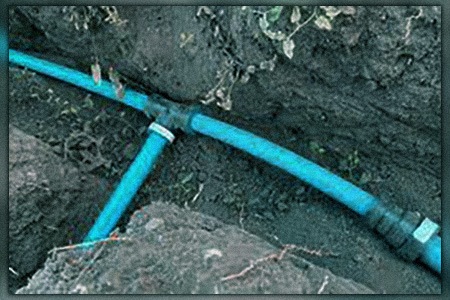
Manufacturers produce PEX-A pipes using peroxide. It's the most flexible grade of PEX and the softest. However, PEX-A has the highest number of cross-links in the polymer, creating a strong, highly durable chemical bond.
So, can PEX be buried? It's the second-best option for use in underground plumbing behind PEX-B. PEX-B is non-corrosive and a better choice than galvanized steel or copper pipes because there's less chance of it leaking and contaminating the groundwater.
However, due to its manufacturing process, PEX-A is likelier to leech chemicals than the two leading options (PEX-B and PEX-A). Plumbers should be aware of this risk when planning installations.
The flexibility in PEX-A allows the material to expand under hot and cold and is a good choice for conditions where the ground freezes and causes water to freeze in pipes. There's less risk of the pipes freezing and cracking in PEX-A installations.
However, PEX-B has more resilience to pressure, making it less prone to bursting in high-pressure systems. It's also superior to PEX-A for use with the risk of freezing in cold conditions.
The flexible nature of PEX-A means it's easier for plumbers to work with than PEX-B, but PEX-B remains the go-to choice for subterranean installations over PEX-A. PEX-A is also more expensive than PEX-B, with pipes costing $3.50 to $7.50 for a 10-foot section.
Burying PEX-B Pipes
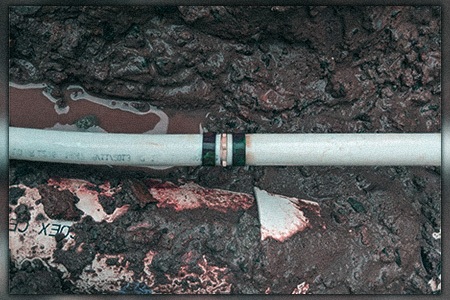
Can you bury PEX pipe? Yes, and if you're looking for the best grade of PEX pipes to bury, PEX-B is the ideal choice for your plumbing project. It's the most affordable option of the three grades, with a ten-foot length costing $2.50 to $5.50. PEX-B offers the same characteristics as PEX-A in many cases but also has a few drawbacks.
As mentioned, PEX-B has better resistance to bursting in high-pressure applications and freezing conditions. Additionally, its non-corrosive properties reduce the chance of chemical leeching making it the superior choice over PEX-A for underground plumbing installations.
When examining the drawbacks and differences between PEX-B and PEX-A, PEX-B undergoes a moisture-cure method in manufacturing. It's a much more rigid material compared to PEX A and more challenging for plumbers to work with during installations.
Additionally, if a PEX-B tube experiences a kink after burying, it requires excavation and replacement. With PEX-A, plumbers don't have to concern themselves about replacing kinked pipes. Heating the material returns it to its initial shape, but manufacturers don't recommend it as a refurbishment strategy.
PEX-B pipes are less flexible than PEX-A due to their lower cross-link ratio. However, for underground installations, the higher burst pressure of PEX-B and its affordable price tag makes it the better choice.
Burying PEX-C Pipes
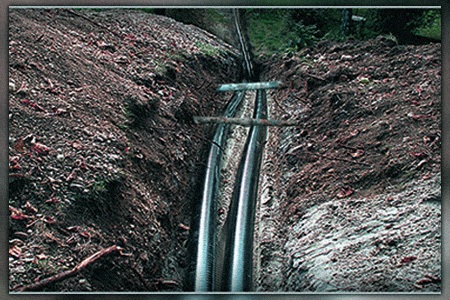
The final primary grade of PEX tubing is PEX-C. This material is unsuitable for underground applications due to its manufacturing using an irradiation process. It's very stiff and the most challenging material to work with in plumbing applications requiring the pipes to have some level of play.
So, can you bury PEX underground? As a result of its rigid properties, PEX-C is the most prone of the three grades to experiencing kinking and cracks in freezing conditions. Burying the pipes in freezing ground temperatures likely leads to frequent bursting and the need for excavation and replacement.
However, PEX-C pipes are the most affordable option of the three grades, with the average pricing for a 10-foot length being $1.75 to $3.50. However, the cost of repairs due to cracking and bursting could increase the need for labor and replacements, driving up maintenance costs for the plumbing system.
PEX-C is better suited to minor, short repairs in plumbing systems where the line requires a sturdy and straight tube. Avoid using it in lengthy applications underground.
Can You Bury PEX Fittings?
PEX A & B pipes are the best choices for underground plumbing systems. However, the durability of the pipes in these systems doesn't account for much if the PEX fittings used in the installation don't have similar properties in underground and freezing conditions.
Crimp fittings, while popular in most plumbing systems, aren't a good choice for use in underground applications. PEX fittings come in two options – crimps and clamps. PEX crimps feature construction with copper, making them unsuitable for burying.
Plumbers must account for the temperature extremes when burying PEX fittings and consider how their use affects functionality. Copper PEX crimps fittings expand when exposed to cold conditions. They expand when the temperatures rise, causing the joint to leak.
The stainless steel clamp is the best choice for use in underground plumbing systems. Stainless steel clamps are highly corrosion-resistant and perform better under temperature fluctuations. However, plumbers should plan their systems to include the minimal use of joints to avoid the need for fittings and the risk of leaks or issues occurring after installation.
Anywhere along the system where you introduce a clamp presents a possible failure point. Keeping joints to a minimum avoids these issues.
Can You Bury PEX Pipes & Other FAQs
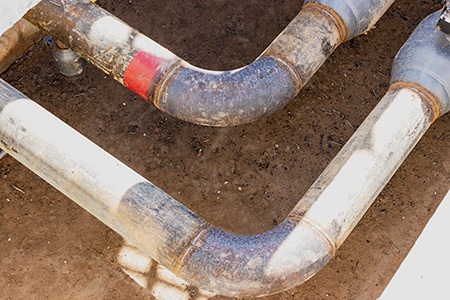
When we start talking about burying PEX underground, a lot more questions come up so we can get a full view on the details. Let’s cover those now beyond whether or not can PEX be used underground.
Do Rodents Chew Through PEX Pipes?
Pest control experts don't understand why rodents chew through PEX pipes. Some assume it's to get at the water moving through the system, while others think rodents find themselves compelled to chew on pipes for the sake of it.
Regardless of the reason for the behavior, rodents and PEX are a bad combination for any PEX installation. Building codes in some areas with high rodent populations prohibit the use of PEX pipes in plumbing installations due to the contamination risk resented by the rodents damaging the pipes.
How Deep Do You Bury PEX Pipes?
The ideal depth for burying PEX pipes in most underground plumbing systems is two feet. This depth is usually below the frost point for the ground, reducing the risk of water freezing in the pipes. Despite PEX, especially PEX-A, being flexible, exposing the lines to freezing conditions is not recommended where you can avoid doing so. Always backfill trenches with soil, not rubble or gravel, to reduce puncture risk with PEX-A pipes.
Can You Bury Spliced PEX Pipes?
Underground PEX plumbing installations should feature no splices. A splice creates a point of failure risk for the system, resulting in a higher risk of excavation and replacement if the pipes leak. Splicing impacts the strength of its waterproof outer shell. Since PEX, especially PEX-A, naturally expands and cracks under temperature fluctuations, splicing should be avoided. Can you run PEX underground? Yes, but choose the type carefully.
What Applications Are Unsuitable for PEX Pipes?
Due to PEX's vulnerability to UV rays, it shouldn't be used in any plumbing installation exposed to direct sunlight. PEX degrades faster than other plastic plumbing solutions when exposed to sunlight for prolonged periods.
Key Takeaways for PEX Pipe Underground
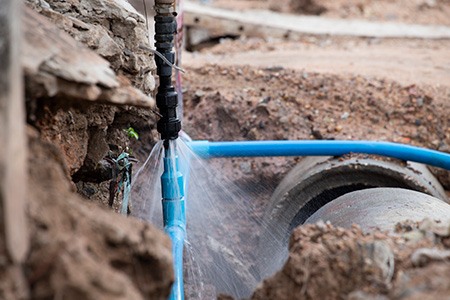
- PEX pipes are a mixed bag for use in underground plumbing systems.
- PEX-A & B are good choices for underground installations.
- PEX-A is more flexible than PEX-B, but PEX-B is more robust and resilient to bursting.
- PEX-C is unsuitable for use in underground plumbing systems due to its manufacturing process and the possibility of soil and groundwater contamination presented by the material.
- The improvements to the PEX manufacturing process over the years since its debut means it's the preferred material for use in over 60% of new residential and commercial plumbing installations.
- PEX pipes come with a 25-year warranty and average service life of 40 to 50 years.
- When burying PEX, install it 2 feet below the soil line for the best resilience to temperature fluctuations.
So, Can You Bury PEX Pipe Underground?
The question of the day is “can you bury PEX pipe?” You can, and the ground can act as a nice insulator as well. You may face other complications such as dealing with rodents chewing through the pipes or anything but stainless steel fittings developing problems. I would try to avoid having any fittings underground to avoid that issue, and then you can feel confident about the process of running PEX underground.



